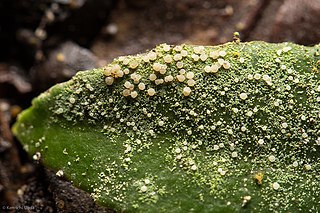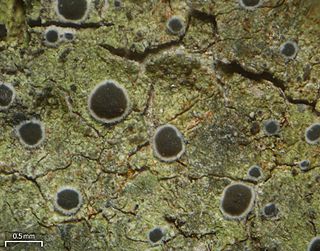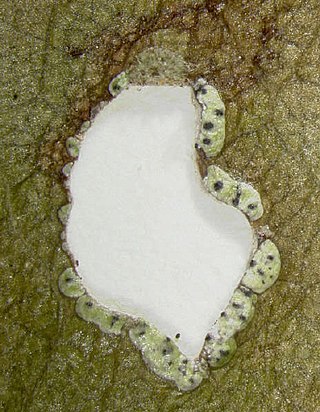
Diorygma is a genus of lichen-forming fungi in the family Graphidaceae. The genus was circumscribed by Franz Gerhard Eschweiler in 1824. Species of the genus are widely distributed in tropical and subtropical regions of the world.

Acanthothecis is a genus of lichen-forming fungi in the family Graphidaceae. The genus was circumscribed by Frederick Edward Clements in 1909.

Fellhanera is a genus of mostly leaf-dwelling lichens in the family Pilocarpaceae. The genus, circumscribed by lichenologist Antonín Vězda in 1986, honours Austrian lichenologist Josef Hafellner.

Calopadia is a genus of foliicolous (leaf-dwelling) lichens in the family Pilocarpaceae. It was circumscribed by Czech lichenologist Antonín Vězda in 1986.

Byssoloma is a genus of leaf-dwelling lichens in the family Pilocarpaceae.
Sporopodium is a genus of lichen-forming fungi in the family Pilocarpaceae.
Septotrapelia is a genus of lichen-forming fungi in the family Pilocarpaceae. It has four species. It was validly published as a genus in 2007 by lichenologists André Aptroot and Jose-Luis Chaves.
Cratiria is a genus of lichen-forming fungi in the family Caliciaceae. The genus has a widespread distribution, especially in tropical regions, and contains about 20 species. The genus was circumscribed by Austrian lichenologist Bernhard Marbach in 2000, with Cratiria lauri-cassiae assigned as the type species.

Gassicurtia is a genus of lichenized fungi in the family Caliciaceae.

Enterographa is a genus of lichens in the family Roccellaceae.

Mazosia is a genus of lichen-forming fungi in the family Roccellaceae. The genus was circumscribed by Italian lichenologist Abramo Bartolommeo Massalongo in 1854.

Bulbothrix is a genus of lichen-forming fungi in the family Parmeliaceae. This genus is synonymous with Bulbothricella V.Marcano, S.Mohali & A.Morales. Bulbothrix was circumscribed by lichenologist Mason E. Hale in 1974 with Bulbothrix semilunata as the type species.

Absconditella is a genus of lichenised fungi in the family Stictidaceae. The genus was circumscribed in 1965 by Czech lichenologist Antonín Vězda, with Absconditella sphagnorum assigned as the type species. Absconditella is characterised by gyalectoid apothecia with a hymenium that is not amyloid, without a dark pigment and thalli containing green algae as photobionts. The genus name means "hidden", a reference to the scant structure of the thallus and its small apothecia.

Strigulaceae is a family of lichen-forming fungi, one of two families in the order Strigulales. Recent (2020) molecular analysis of the type genus, Strigula, has led to a reallocation of the foliicolous species into six genera that correspond to well-delimited clades with diagnostic phenotype features.

Coenogonium is a genus of filamentous lichens in the monotypic family Coenogoniaceae. It has about 90 species. Most species are leaf-dwelling or grow on bark, although a few are known to grow on rocks under certain conditions, and some are restricted to growth on termite nests. The genus was circumscribed in 1820 by German naturalist Christian Gottfried Ehrenberg.
Eugeniella is a genus of mostly leaf-dwelling (foliicolous) lichens in the family Pilocarpaceae. It contains 13 species. The genus was circumscribed in 2008 by lichenologists Robert Lücking, Emmanuël Sérusiaux, and Klaus Kalb, with Eugeniella psychotriae assigned as the type species. This lichen was originally called Patellaria psychotriae by Johannes Müller Argoviensis in 1881. The seven species that were initially included in the genus had previously been placed in the genera Bacidia and Byssoloma. Several newly identified species from Australasia and Central and South America were later added. Most of the species grow on leaves, although four of the Australasian species grow on bark.

Loxospora is a genus of lichen-forming fungi in the family Sarrameanaceae. It has 13 species. The genus was circumscribed by Italian lichenologist Abramo Bartolommeo Massalongo in 1852, with Loxospora elatina assigned as the type species. This crustose lichen was originally named Lecanora elatina by Erik Acharius in 1810.
Henricus (Harrie) Johannes Maria Sipman is a Dutch lichenologist. He specialises in tropical and subtropical lichens, and has authored or co-authored more than 250 scientific publications. He was the curator of the lichen herbarium at the Berlin Botanical Garden and Botanical Museum from 1983 until his retirement in 2010.

Robert Lücking is a German lichenologist. He earned his master's and PhD from the University of Ulm, focusing on the taxonomy, ecology, and biodiversity of foliicolous lichens. He has received numerous awards for his work, including the Mason E. Hale Award for his doctoral thesis, the Augustin Pyramus de Candolle prize for his monograph, and the Tuckerman Award twice for his publications in The Bryologist. Since 2015, he has been serving as the curator of lichens, fungi, and bryophytes at the Berlin Botanical Garden and Botanical Museum, and several lichen species and a genus have been named in his honour.













